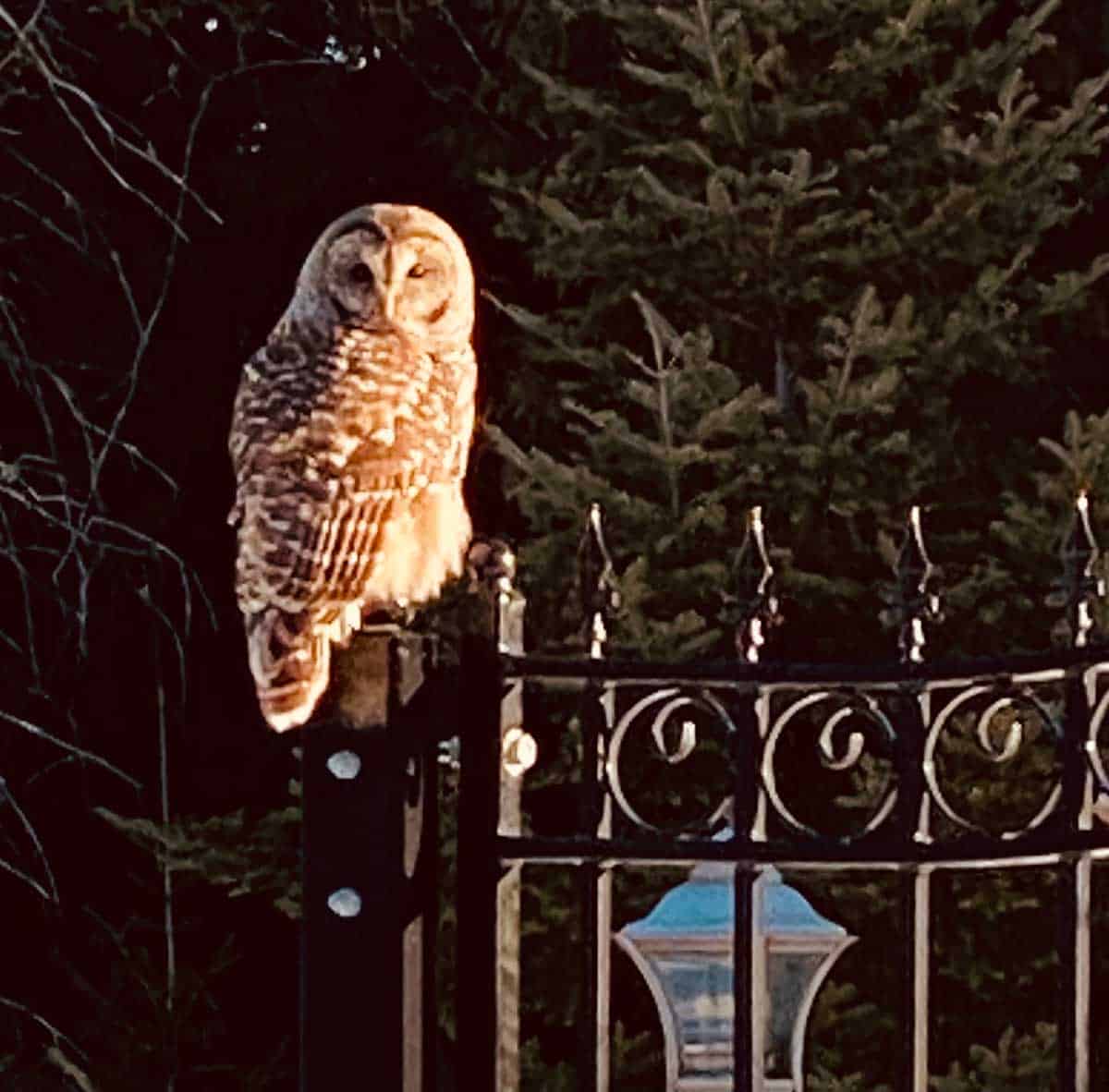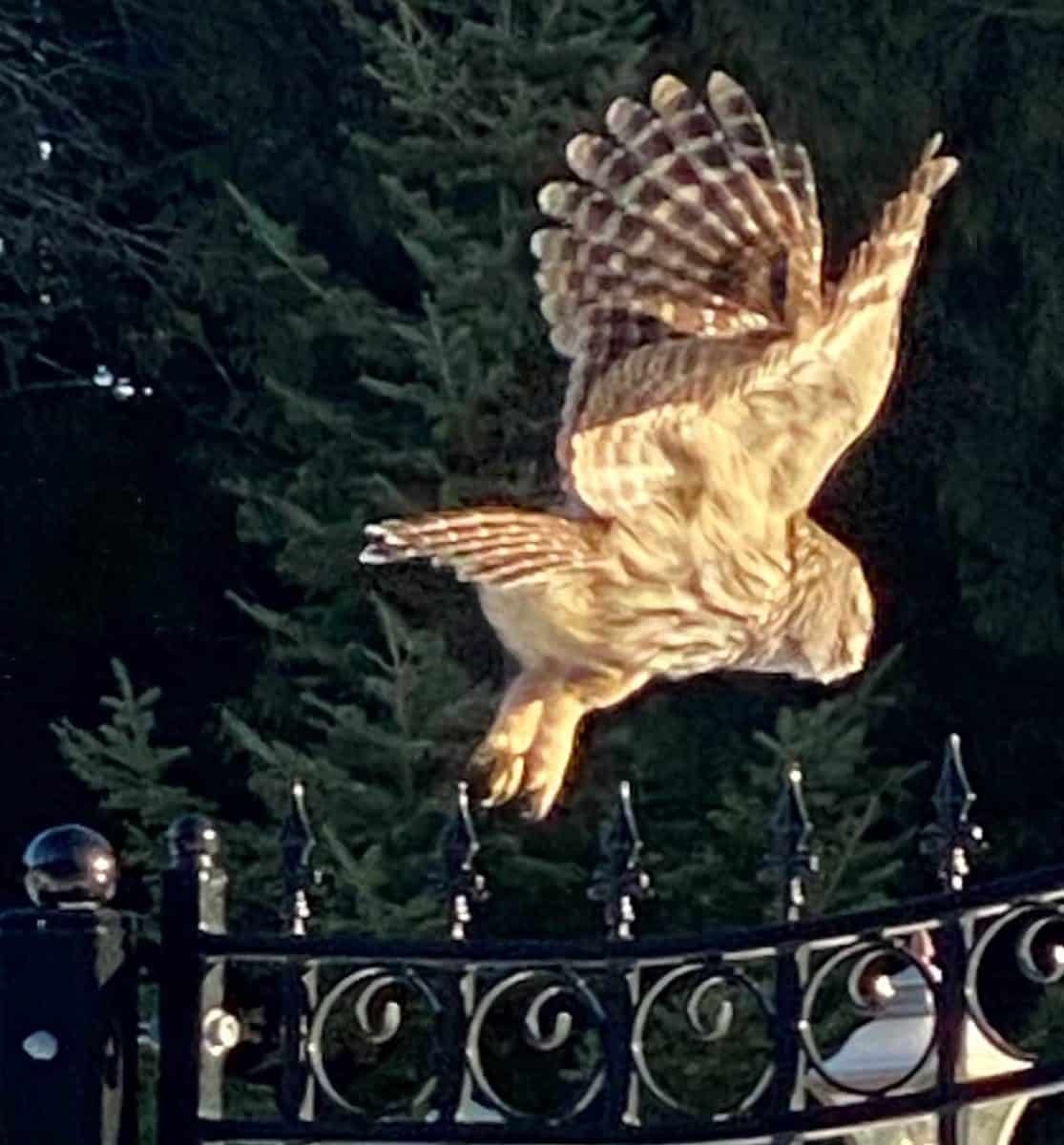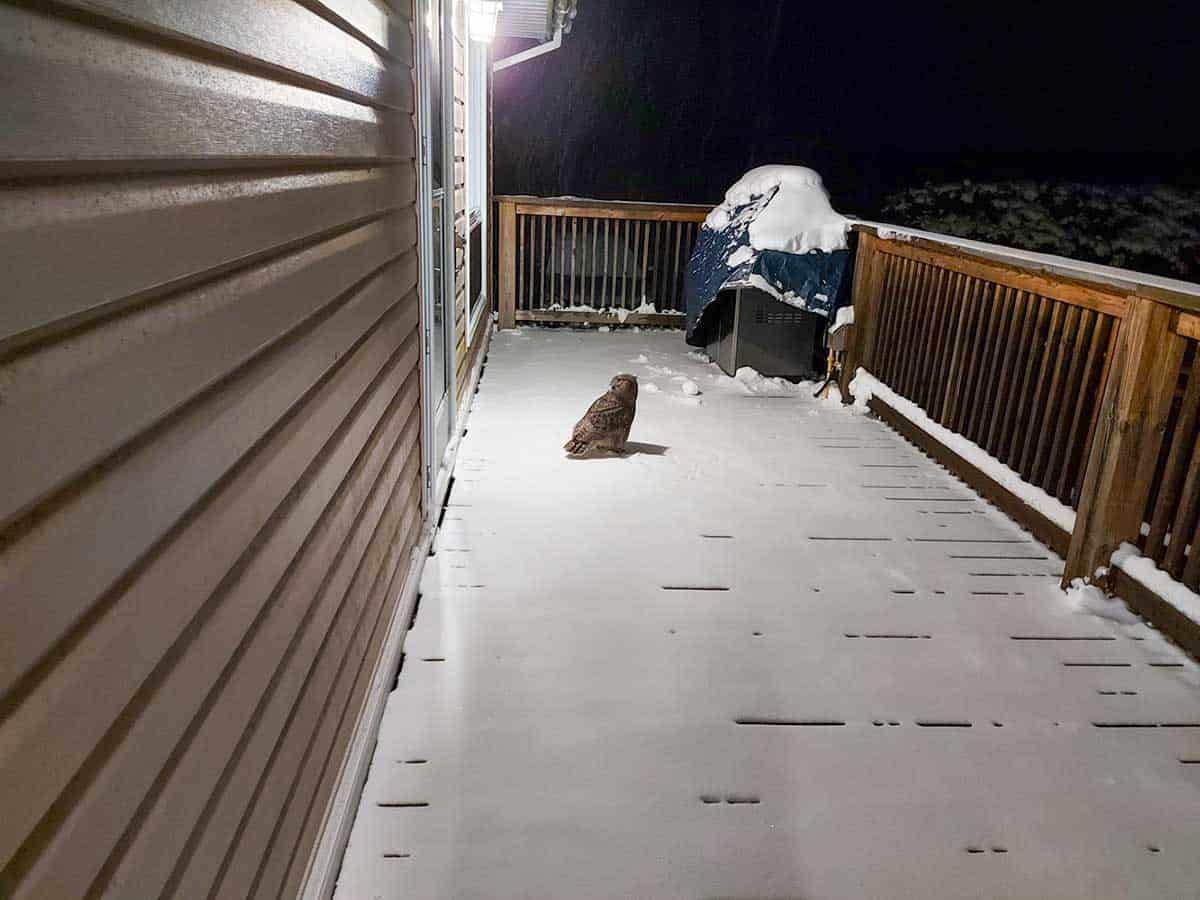MANITOULIN – People in Providence Bay and Michael’s Bay on the southern portion of Manitoulin Island have faced repeated visits from aggressive owls over the past two weeks, which have resulted in the death of a dog and injuries to at least two people in the Providence Bay area alone.
“I’m from the Island and have lived in the North all my life. I’ve never seen any animals like this one and I hope it’s the last time I see one of these,” said Greg McFarlane, of Cranston Road in Providence Bay. “It was a bird from hell.”
The first owl encounter happened on Thursday, February 11. Mr. McFarlane’s wife Sherry Anderson McFarlane, who is also originally from the Island, was sitting in her wheelchair on their covered porch at about 6:45 pm. Suddenly, she suffered a strong blow to her head—enough to cause her to momentarily black out.
As she slowly came to, she thought someone had hit her with a baseball bat, but soon realized she had cuts and scrapes all over her face. One of the slashes was less than an inch from her eye. This was the work of a great-horned owl.
Friday was quiet but as the two were inside on Saturday, they heard a massive bang as the owl returned and slammed into one of their windows. This stunned the creature and it stayed on their deck for about half an hour. Mr. McFarlane managed to take some pictures of the owl as it recovered.
On Sunday evening, the owl returned and brought tragedy. Mr. McFarlane let his dogs out but his 14-year-old Shih Tzu, Asia, did not return swiftly as she normally did. He went out and saw that the owl had returned and held the small dog in its talons.
Mr. McFarlane ran over and kicked the owl twice. It eventually flew off but left Asia limp and lifeless. She revived a bit once Mr. McFarlane brought her inside but had raspy breathing, was bleeding near her neck and shaking. She spent the night at Island Animal Hospital in Mindemoya.

When the McFarlanes returned from the vet, the owl was perched in the same spot it had attacked Asia. It flew to a few spots on the property before settling into a perch on their deck overnight. Family members who came over to help during the ordeal were afraid to go to their cars, knowing that the raptor was keeping a close watch.
The next morning, Mr. McFarlane let his dogs out at around 8 am and in less than a minute, the owl grabbed Baxter, their male dog, by the neck. He suspects the owl stayed by the house all night waiting for the dogs to come out.
Mr. McFarlane kicked the owl off again but it seemed largely unconcerned with his presence. Fortunately, Baxter was largely unharmed.
At noon, they picked up Asia, who seemed to be in better spirits but still had difficulty breathing and would neither eat nor drink. As the hours passed, she grew weaker and died around 5 pm on Monday, February 15.
That day was the last time the McFarlanes saw the owl on their property.
Family seeks answers, peaceful resolution
When discussion emerged online about the incident, many commenters were quick to suggest that the owl must die. Despite their painful ordeal, the McFarlanes did not immediately suggest dispatching the creature.
Instead, they wished to better understand the aggressive behaviour and sought information from experts. They also contacted Rainbow Rescue’s Bleu Fisher, who baited and set three cat traps and a modified dog trap on the property to hopefully capture the animal. Cat traps have been known, on occasion, to capture owls, she said.

After several days of the traps in place, there were still no owl sightings. Ms. Fisher’s plan was to take it to Turtle Pond Wildlife Centre in Sudbury for rehabilitation, where it may have further moved to a raptor centre for advanced rehabilitation.
Ms. Fisher praised the McFarlane’s desire for a non-lethal solution, if possible. She also cautioned against armchair experts who spread theories online such as the owl possibly being rabid (birds cannot contract rabies).
Word of the owl incident reached Garth Baker, a member of Ontario Bird Banding Association and a bird bander (one who attaches a tracking tag to birds’ wings or legs for research and monitoring purposes) with Canadian Wildlife Service. The retired Canadian Pacific conductor referred to himself as a citizen scientist, having a four-decade-long passion for birds of prey.
“I’ve never heard of someone being attacked when they were sitting on their deck. For me it’s definitely unprecedented,” he said.
Mr. Baker happened to be spending several months with his sister in Billings Township when the incidents took place, and he quickly offered his services to help the family find answers.
“To me, it seems like this is food-driven, or rather a lack of food. I’ve snowshoed around in the bush and I haven’t seen many signs of hares, which are owls’ primary food in the bush at night,” said Mr. Baker, adding that the recent string of frigid nights may have kept smaller critters burrowed away after sundown, which is when owls are most active and feeding.
He visited the property to search for a nearby nest, a possible motive for defensive owl behaviour, but did not see any nearby. He also played audio owl lures for a half hour on the property and did not hear any calls back, something he said he would have expected if there was a nest nearby especially.
Mr. Baker also praised the McFarlanes for not moving to kill the bird, especially when it was defenceless on their deck after stunning itself on their window. He noted that owls are protected under the federal Migratory Birds Convention Act and killing or harming them could result in fines or charges.
“Sherry and Greg have every right to feel angry because they basically felt targeted for three days, having the owl come back over and over. But (instead, they said) ‘we’re living in an area with nature and this is what nature does,’” he said. “People need to lose the lynch mob mentality with stuff like this. Once I saw how people were reacting to it, that’s what got me more interested in helping out.”
After the final incident with Baxter, the McFarlanes have not seen the owl on their property again. But in the midst of their plight, others have faced similar challenges.
Neighbours face owl aggression
On Friday, February 12, the day the owl did not appear at the McFarlane house, it instead flew to the home of Greg Paquet, a few driveways up Cranston Road.
Mr. Paquet was having a bonfire when his friend’s four-and-a-half-year-old daughter fell over. At first, they thought she may have tripped on a stump but they soon understood an owl had taken hold of the young girl.
“Her father realized and he stepped in and ripped the bird off. It had latched on pretty good,” Mr. Paquet told The Expositor. “I’ve spent a lot of time in the bush hunting, fishing, and I’ve seen owls pretty close but never encountered anything like this, which makes it odd.”
The girl was fortunately not seriously injured, having only faced scrapes to her head.
After some searching in nearby trees, they could not spot the raptor and called it a night. The next day, Mr. Paquet went outside to clean up the property.
“Within 30 seconds, this bird came down and went at my dog. Now, my dog’s got a bit of an attitude so it took care of it on its own and I later saw the owl up in a tree,” he said. Later that night was when the owl mortally wounded the McFarlanes’ Asia.
“We were living in Sudbury and we moved back here to be more comfortable. We just started letting our kids walk to the bus but now we’re worried about this damn owl. It’s kind of a problem, but I’m sure it won’t last too long,” said Mr. Paquet.
Although he is a hunter and said he had no qualms about shooting the bird if it was attacking him or his family, he said he did not wish to harm it if at all possible.

Alan MacNevin captured these photos of what he believes is the same owl that attacked him. photo by Alan MacNevin 
He took these photos this past fall as the barred owl basked in the evening sun. photo by Alan MacNevin
Biologists say behaviour is rare
Owl attacks of this nature are rare and most often happen when the raptors are trying to protect their nests and offspring from potential dangers, said biologists Annick Gionet Rollick and Brian Hayhoe of The Owl Foundation, based in Vineland Station.
However, when desperate, owls may become aggressive over their territories or potential prey items.
“A healthy owl tends to stick to known prey items that were provided to them as owlets and fledglings. They will go ‘off-menu’ if they become desperate, like a small pet. A healthy animal does not want to risk injury and will hunt prey items that they are familiar with,” the foundation stated in an email to The Expositor.
Further potential reasons for aggression include owls that have been imprinted to humans, if they were raised in captivity and released, because they may see humans as competition for mates, territory and food.
The foundation shared steps people can take to lower the risk of attacks. If it is nest-related aggression, locate the nest and avoid the area if possible. If a nest is near a home, keep watch for the owl when outside and consider wearing a hat with eyes drawn on the back—owls prefer a surprise attack approach. Owl decoys can also divert the raptor’s aggression.
Nesting-related aggression can last up to four months, but the nesting period normally begins in mid-March to early April.
If owl aggression is food-related, The Owl Foundation said to never leave pets unattended and keep them leashed. It suggested that people go outside in pairs.
“Never feed an owl. You do not want to habituate or tame wildlife to humans. This will lead to future conflicts. If this is an imprinted owl, intervention may be required, seek help from a biologist or wildlife rehabilitator,” it concluded.
Michael’s Bay residents have separate owl incidents
Owl incidents also happened beyond Providence Bay around the same time. In Michael’s Bay, about 15 kilometres from Providence Bay in a straight line, at least three people have recently faced owl attacks.
The Expositor has learned that people at three separate households in Michael’s Bay also faced owl attacks around the same time. On February 12 at around 5:30 pm, Alan MacNevin was walking up the road, looking at his phone, when—like Ms. McFarlane—he was struck on the back of the head.
The blow was strong enough to knock him down and cause a momentary blackout, which he thought may be a very mild concussion.
“I certainly got my bell rung, and I went to get a tetanus shot just in case,” he told The Expositor. “It put five holes into me.”
Mr. MacNevin said he thought the owl may have been defending its territory because it remained nearby and stared at him as he recovered.
“I grabbed my gloves and my phone to get a picture, because I figured nobody would believe me,” he said. “When I got up, it kept coming toward me, so I’m thinking I must have disturbed it.”
This creature was a barred owl; Mr. MacNevin said he has seen it several times since he moved into the former Royal Michael’s Bay Resort property last summer.

“I feel bad for everybody who’s all upset and saying we have killer owls. They’re just doing their thing,” he said. “I imagine there’s a whole lot more commotion here than there was 12 years ago. I suspect he or she didn’t do anything unnatural; I was just an easy target walking at night with a hat that might have looked like a squirrel.”
As for The Owl Foundation’s suggestion of wearing a set of ‘eyes on the back of his head,’ Mr. MacNevin said he would first focus on keeping more aware of his surroundings as he walked around.
“Maybe it was laying down a warning shot, saying ‘you better leave me alone,’ which is fine by me,” he said. “I’m just going to keep my eyes open; as long as it doesn’t bother me or my dog we’ll have no problems.”
In the following few days, other neighbours reported incidents with owls.
Bird bander responds to Michael’s Bay incidents
Mr. Baker said he was not surprised that it was a different individual that had shown aggression in Michael’s Bay because of great horned owls’ tendency to stay in a limited range of about eight to 10 square kilometres for their whole adult lives. However, he said barred owls tend to start nesting later in March and April, so he suspected this may be more food-related behaviour during the cold snap.
Barred owls are semi-migratory and move much farther than great horned owls. They are somewhat smaller than great horned owls and tend to feed on mice and squirrels, generally preferring smaller prey than the larger raptor.
“I do know that this is a big year for barred owls around Ontario; there’s lots being spotted,” he said, adding that he caught three this fall at his banding station, his highest-ever total. “They’re probably more common to be seen than the great horned owl because (barred owls) are sometimes out in the daytime, sitting in the sunshine basking. We’re seeing lots of pictures from people right now because they’re being seen more in the daylight.”
After the Family Day weekend’s incidents, all was quiet on the part of the owls. The Cranston Road residents had not seen the owl from afar, let alone close to any of their homes.
That changed Thursday, February 18, when Elaine Cranston said the people that live upstairs above her spotted it on their property and making noise. It fortunately did not come closer, as those individuals also have a small dog. A trap went up on that property but this newspaper has not heard of any further sightings as of press time Monday.
As for Ms. McFarlane, who first faced the owl, it took nearly a week before she had a peaceful night’s sleep after her attack. She thanked Mr. Baker for his help and support as they sought answers.
“I hope (the owl has) found whatever it’s after in the last few days, because it’s been leaving us alone at night, and that it doesn’t come back,” she said.
The Manitoulin West Recorder reported on a Providence Bay owl attack in February 2019, though the circumstances were different from this series of incidents. Glenn Black was injured when he removed a great horned owl from his chicken coop after it had killed five of his birds.






